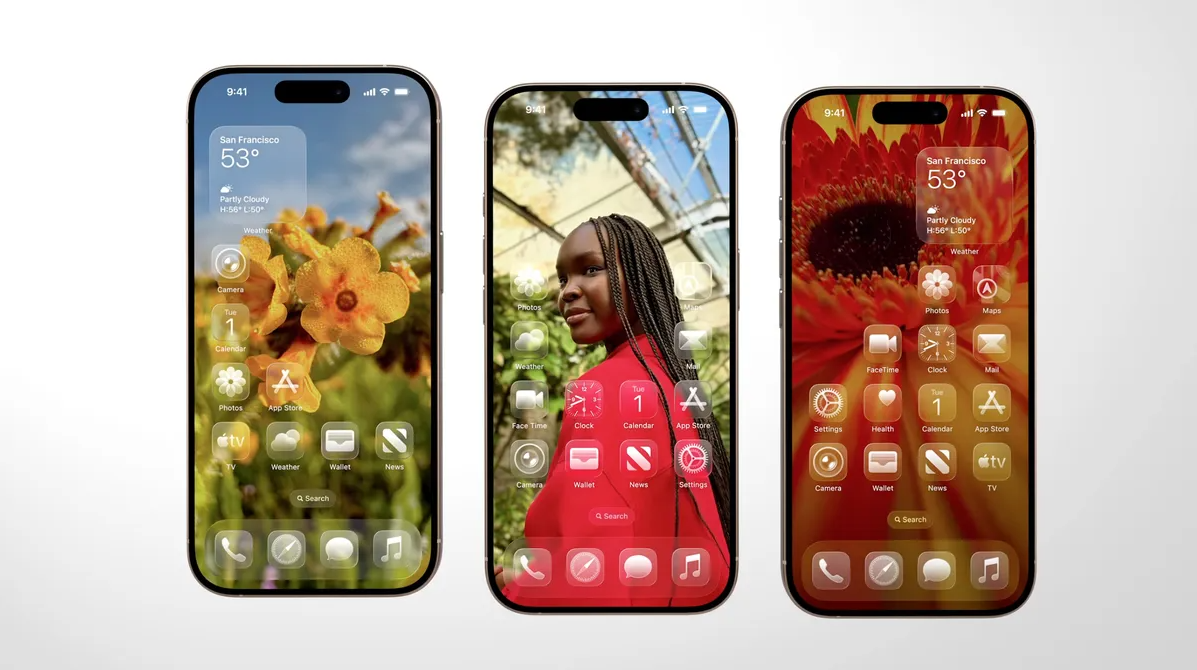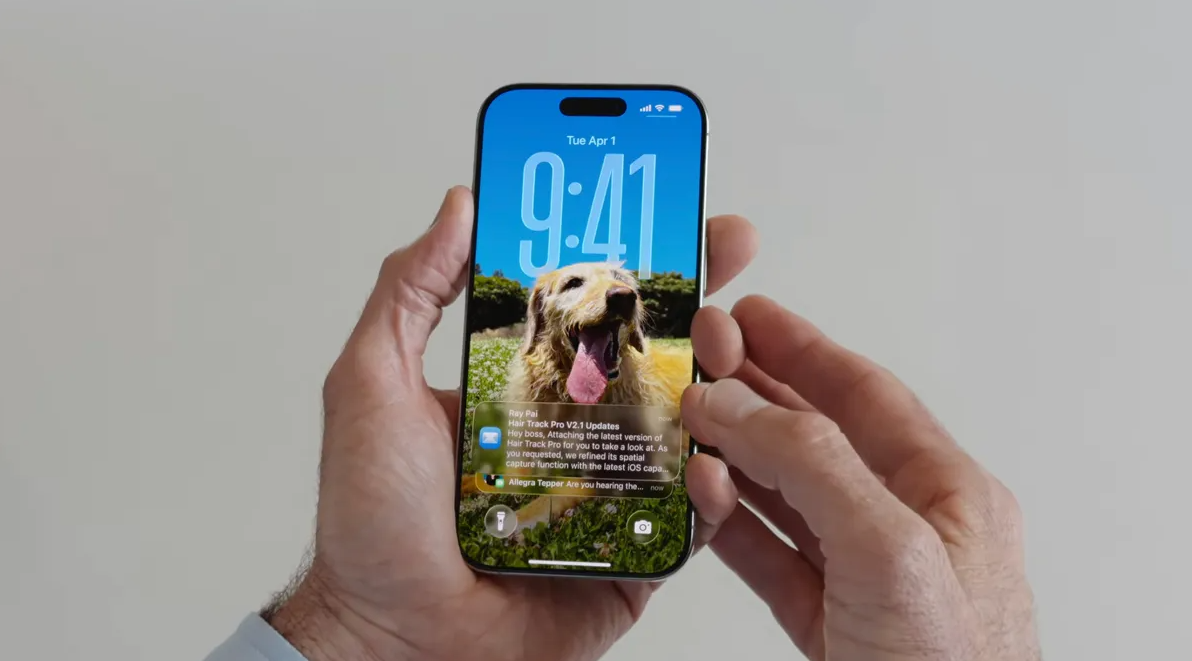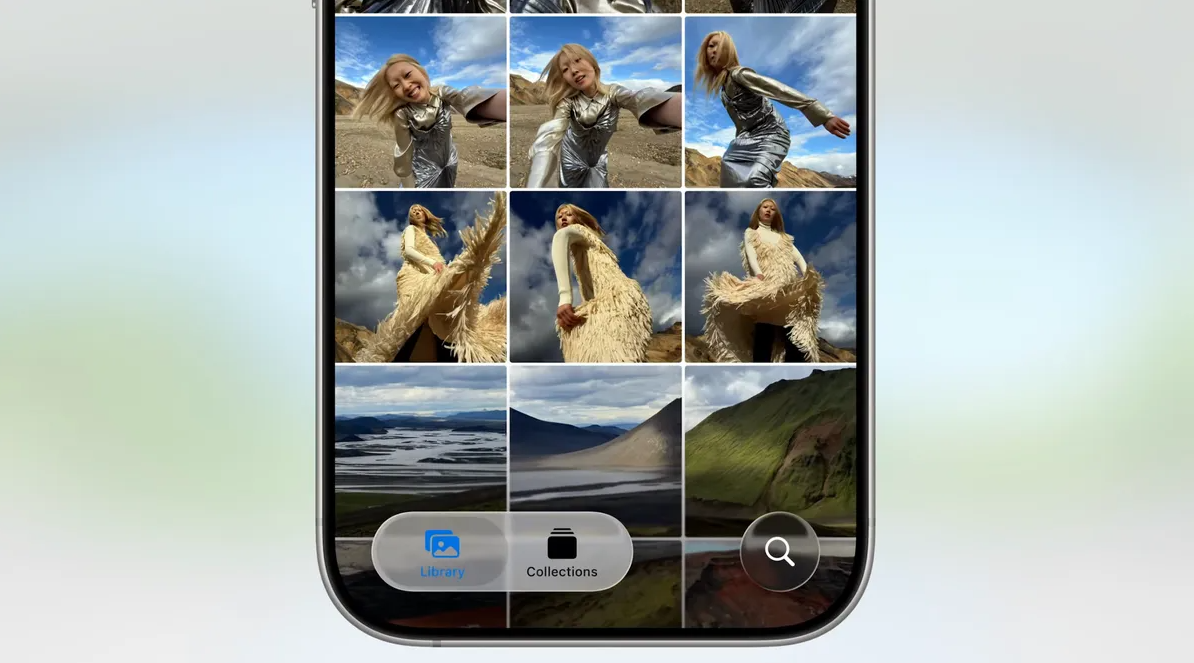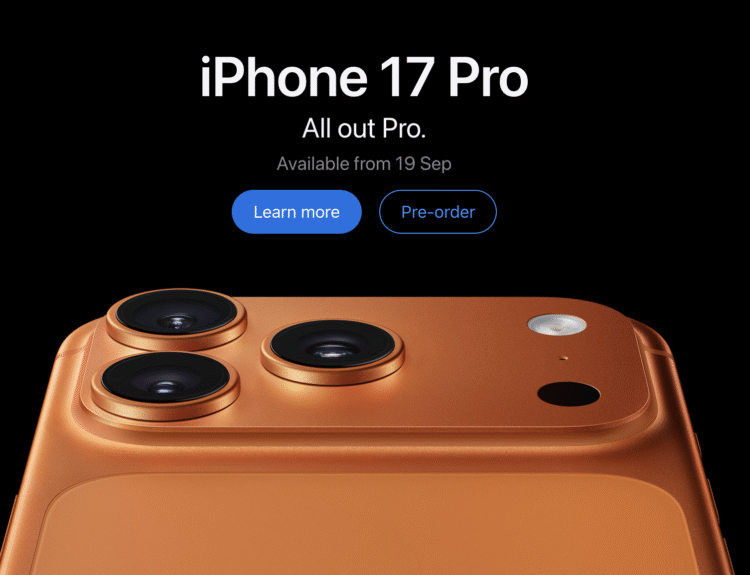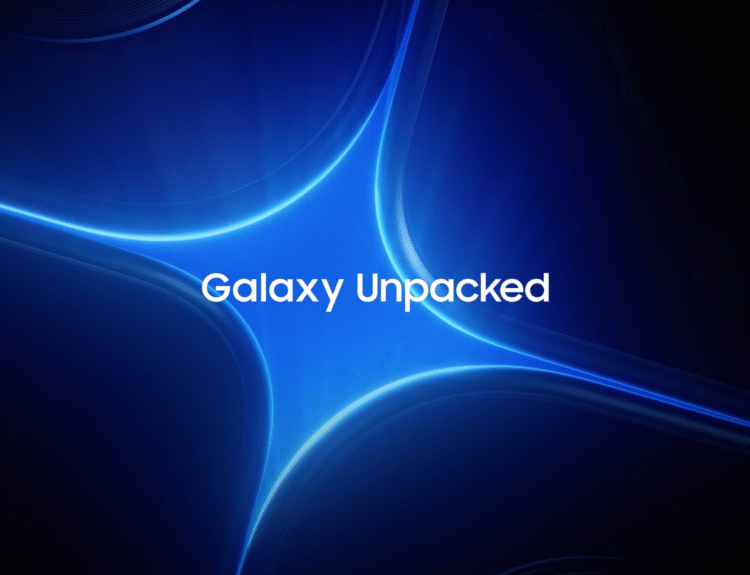The Apple Event 2025, also known as WWDC 2025 (Worldwide Developers Conference), just concluded — and as always, it delivered a mix of groundbreaking updates, futuristic tech visions, and developer-focused innovations. Held virtually and streamed globally, this year’s conference was packed with major announcements that showcase Apple’s continued push into AI, spatial computing, and seamless device integration.
Why does WWDC matter? While Apple’s September events usually bring new hardware like iPhones and Apple Watches, WWDC is all about the future of Apple’s software ecosystem — the operating systems that power billions of devices around the world. It’s where developers, tech enthusiasts, and Apple fans get a first look at what’s next.
In this article, we’ve compiled a complete WWDC 2025 summary, focusing on the most important updates, including the unveiling of iOS 26, improvements to macOS, iPadOS, watchOS, and visionOS, and the new tools that will shape the next generation of apps and experiences.
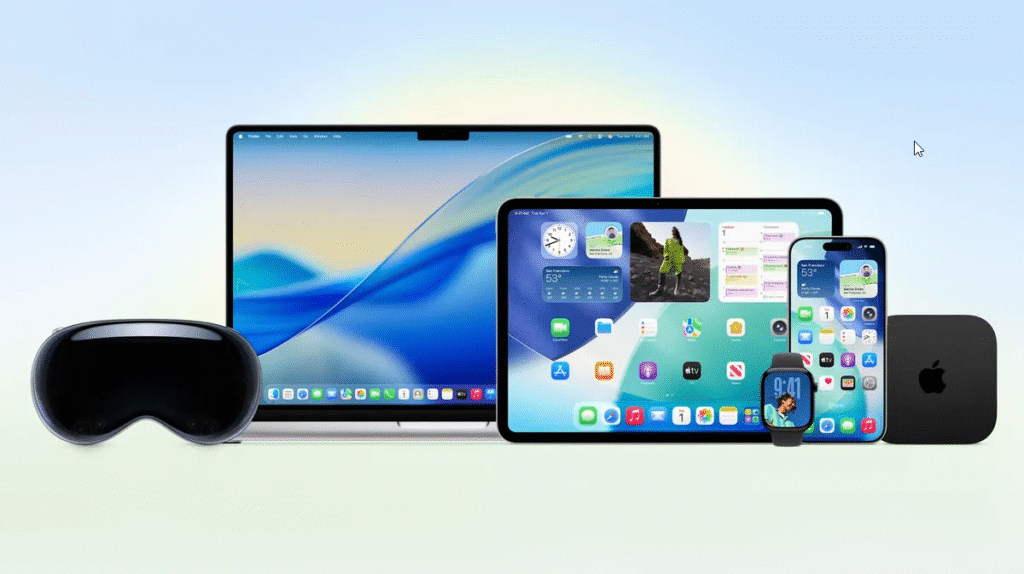
🚀 iOS 26: What’s New
One of the biggest highlights of WWDC 2025 was the official announcement of iOS 26, which marks a major leap forward in Apple’s mobile operating system. With AI deeply embedded throughout the experience, a refined user interface, and smart automation features, iOS 26 feels like Apple’s most intelligent and personalized iPhone OS to date.

✨ Design and Interface Enhancements
Apple has introduced a sleeker, more dynamic home screen in iOS 26 with interactive widgets that can now be used directly without launching apps. Dynamic color themes adjust to your wallpaper, offering a truly personalized visual experience. The Control Center has been revamped for faster access to key settings, and a new Lock Screen stack enables users to switch between layouts based on time, location, or focus modes.
🧠 AI Integration and Smart Features
Apple is stepping confidently into the AI race with “Apple Intelligence”, a set of new features that bring on-device machine learning to the forefront. Some key capabilities include:
- Smart Summaries for notifications, messages, and even Safari tabs
- AI-enhanced Siri, now more conversational and context-aware
- AI-generated replies in Messages and Mail
- Real-time transcription and summarization in Notes and Voice Memos
These features are designed to run on-device for maximum privacy and minimal latency, leveraging Apple’s custom silicon.
🔐 Privacy and Security Upgrades
In iOS 26, Apple doubles down on privacy with features like Private Cloud Compute, which allows certain AI tasks to run securely in the cloud without logging user data. There’s also a new App Privacy Dashboard that visualizes which apps have accessed sensitive permissions over time.
📱 Device Compatibility
Not all devices will support iOS 26, especially those running on older A-series chips. The expected compatible models include:
- iPhone 15 series and newer
- iPhone 14 and 13 with limited AI features
- iPhone SE (3rd Gen) supported, but AI features restricted
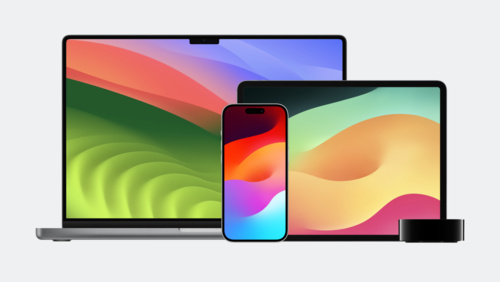
📆 Beta and Release Timeline
- Developer Beta: Available now via Apple Developer Program
- Public Beta: Expected mid-July 2025
- Official Release: September 2025 alongside iPhone 17
🌊 Liquid Glass: Apple’s Bold New Design Language
One of the most visually striking announcements at WWDC 2025 was the introduction of Liquid Glass — Apple’s next-gen design system.
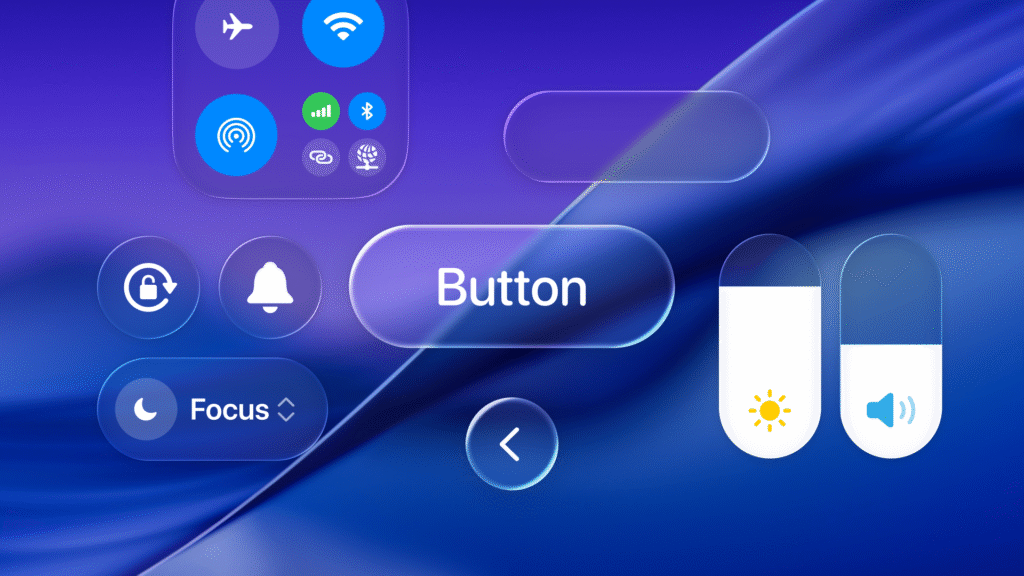
✨ What is Liquid Glass?
It’s more than just rounded corners or translucency. Liquid Glass blends dynamic lighting, depth, and motion into a cohesive UI that feels alive. Across iOS 26, macOS 15, and visionOS 2, you’ll notice:
- Frosted transparency that adapts to your wallpaper or context
- Interactive shadows and layered animations
- Smooth, 3D-like motion physics in transitions and controls
🔁 Why It Matters
Apple wants a seamless feel across its ecosystem, and Liquid Glass delivers just that. Developers can now access LiquidGlassKit to bring native-like polish to third-party apps. It’s not just about looks — it’s about making software feel more human.
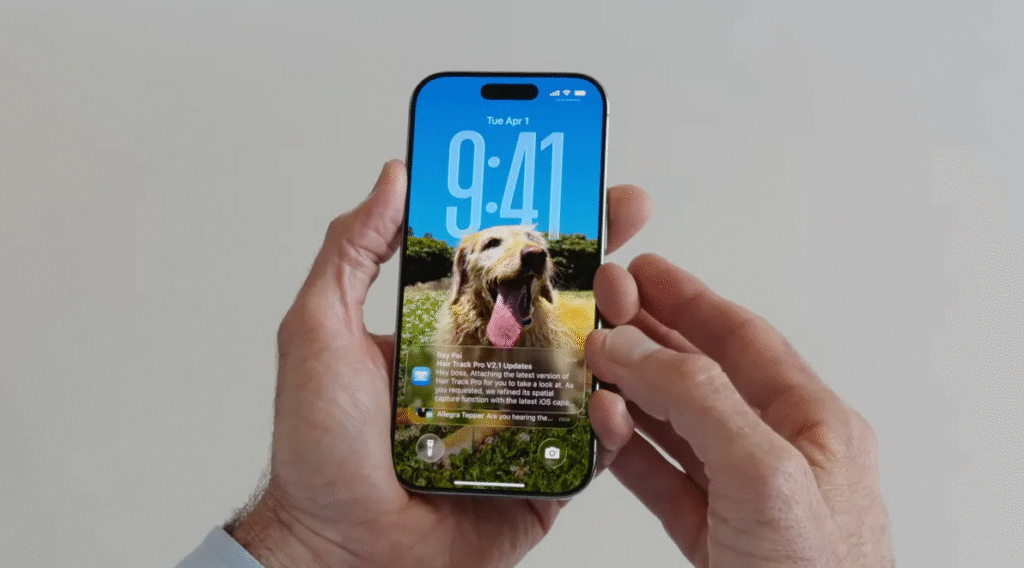
📅 A Unified OS Naming Convention

Another subtle shift in WWDC 2025 was Apple’s new naming format. All platforms now follow a year-based versioning system:
- iOS 26
- iPadOS 26
- macOS 26 (codenamed “Tahoe”)
- watchOS 26
- visionOS 26
- tvOS 26
This not only aligns Apple’s annual cycles but makes it easier for developers and users to track compatibility.
📞 Phone App Comes to Mac
macOS 15 “Tahoe” didn’t just get smarter — it got more connected.
Apple introduced a Phone app for Mac, letting users:
- Make and receive calls directly from their desktop
- Listen to voicemails with transcripts
- Screen unknown numbers using AI spam filters
No need to reach for your iPhone — your Mac is now your full-fledged communication center.
🎮 PSVR2 Support & Apple’s New Games App
Gaming made a surprise splash at WWDC 2025.
Apple announced that the Apple Vision Pro now supports PlayStation VR2 controllers, unlocking advanced motion tracking and console-style gameplay in mixed reality.
Alongside this, a brand-new Games App was launched, unifying:
- Apple Arcade
- Game Center social features
- Your friends list, achievements, and game progress
This makes gaming across Apple devices smoother, more social, and more immersive than ever.
🔊 AirPods Pro 3 Leak in iOS 26 Beta
While not officially revealed on stage, developers digging into the iOS 26 beta discovered references to AirPods Pro 3, expected to debut later in 2025.
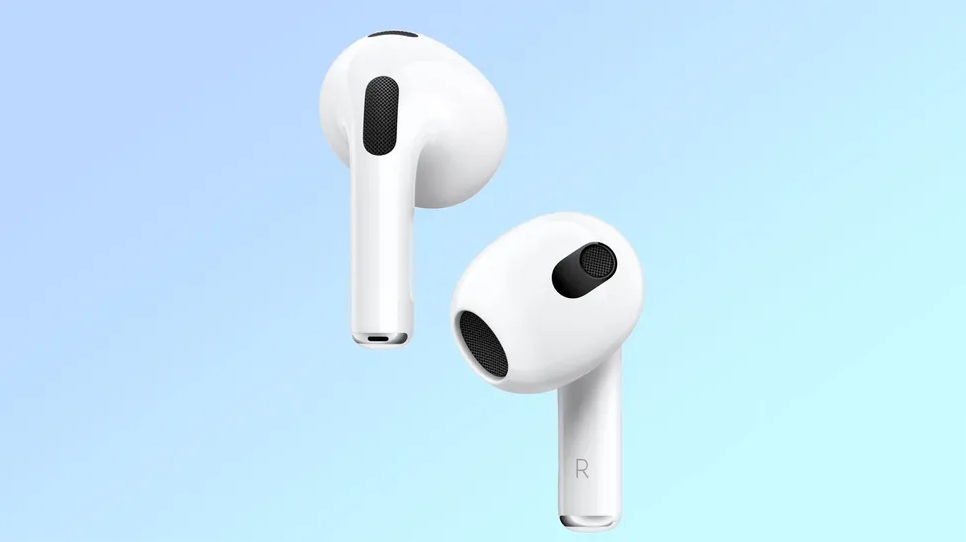
Key rumored upgrades:
- Enhanced spatial audio with real-time head tracking
- Smarter adaptive transparency
- Deeper integration with Apple Intelligence features
This suggests Apple is preparing hardware updates that match the intelligence and responsiveness of its new software ecosystem.
💻 macOS 15 & iPadOS 19: Desktop-Class Power, Seamless Continuity
While iOS 26 took the spotlight, Apple didn’t hold back on delivering major updates for its desktop and tablet ecosystems. macOS 15, rumored pre-event as “Mammoth,” brings meaningful refinements for productivity and collaboration, while iPadOS 19 continues Apple’s mission to blur the line between tablets and traditional computers.
🖥️ macOS 15: Mammoth Performance, Smarter Apps
With macOS 15, Apple focuses on speed, collaboration, and tighter integration across Apple devices. Highlights include:
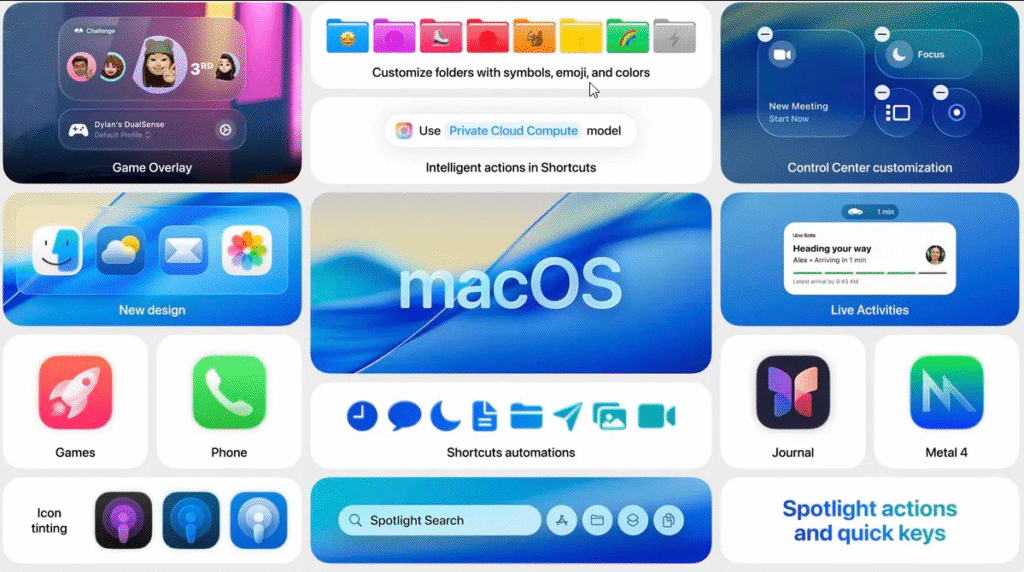
- Quick Connect: A new universal clipboard and drag-and-drop experience between Mac, iPad, and iPhone — faster and more stable than ever.
- Live Collaboration Spaces: Deep integration with FaceTime and Freeform lets multiple users co-edit documents, presentations, and whiteboards in real-time.
- AI-Boosted Spotlight Search: Now with contextual understanding, Spotlight can summarize documents, suggest next actions, and even find files based on your voice.
- Safari Revamp: Enhanced Reader Mode with AI-generated page summaries and auto-grouping of tabs based on topic or project.
macOS 15 also gets a new “Work Focus” mode, designed to silence notifications and optimize performance during app-intensive workflows like video editing or development.
📝 iPadOS 19: Unlocking the iPad’s Full Potential
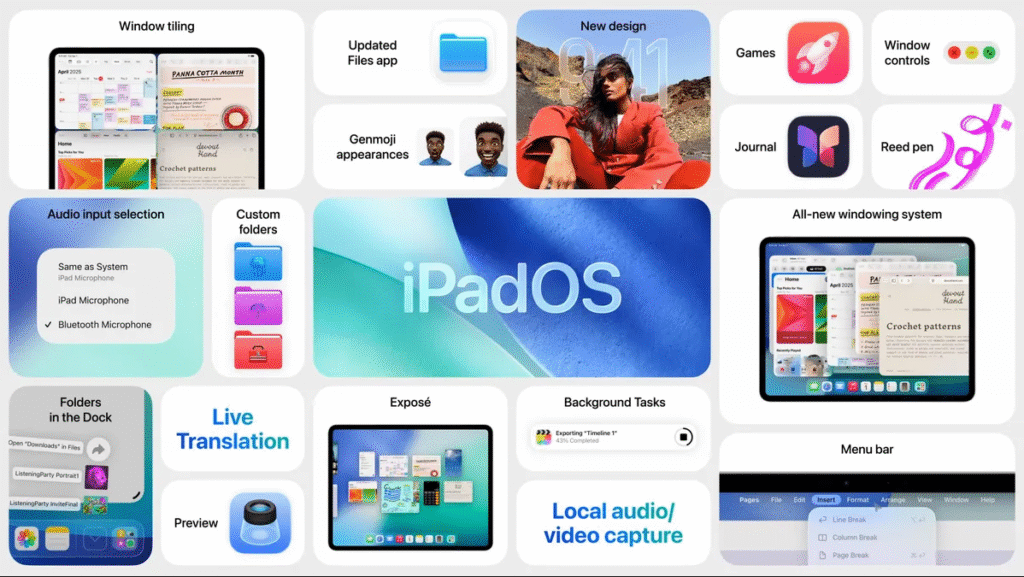
Apple continues its push toward making the iPad a true laptop alternative. iPadOS 19 introduces:
- Resizable App Windows: Users can now resize and snap app windows, creating a much more desktop-like multitasking experience.
- Final Cut Pro & Logic Pro Updates: With trackpad and keyboard support enhancements, these apps now offer near-identical workflows to the Mac versions.
- Apple Pencil Pro Tools: Developers can create custom pencil gestures in their apps, opening doors for creative professionals.
Also notable is the AI-powered handwriting to text conversion, which works even with rough input in real time, and a new Multiplayer SharePlay for collaborative gaming or learning apps.
🔗 Seamless Continuity Across Devices
Both macOS 15 and iPadOS 19 benefit from Apple’s vision of seamless device harmony. New continuity features allow for shared Face ID unlock, universal control across three devices simultaneously, and smart clipboard syncing that respects app boundaries and security policies.
🥽 visionOS 2 and the Evolution of Apple Vision Pro
Apple’s visionOS — the operating system that powers the Apple Vision Pro — received a major upgrade at WWDC 2025, solidifying Apple’s long-term investment in spatial computing. With visionOS 2, Apple aims to transform the Vision Pro from a futuristic showcase into a practical daily-use device for work, entertainment, and creativity.
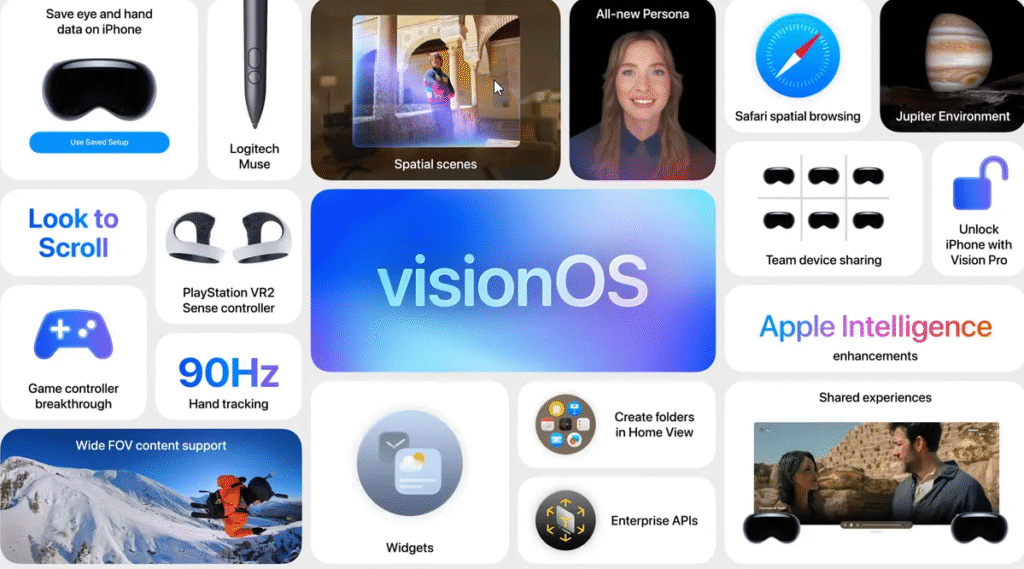
🌐 visionOS 2: A Smarter, More Immersive OS
visionOS 2 introduces enhanced depth recognition, more intuitive hand gestures, and AI-assisted spatial layout organization. Some of the standout new features include:
- Live Spatial Desktop: Users can now bring their entire Mac display into a virtual workspace with full 3D window interaction, perfect for multitasking and coding in mixed reality.
- Context-Aware Environments: visionOS can now suggest immersive environments based on your calendar (e.g., “Focus Zone” for work hours or “Zen Garden” for meditation breaks).
- Expanded Eye & Hand Tracking: Improved responsiveness and accuracy in hand gestures, making pinch-to-select and zoom more seamless.
- Personalized Avatars: With Vision Pro, users can now create more expressive digital personas for FaceTime, complete with realistic facial expressions and upper body movement.
🎮 Apps, Games, and Developer Opportunities
Apple announced the expansion of the visionOS App Store, highlighting creative apps like Adobe Firefly for spatial design, Unity-powered games, and immersive educational platforms. Developers now have access to:
- Reality Composer Pro 2: A new tool to design mixed reality experiences with AI-generated scenes and transitions.
- SpatialKit: A new API that allows developers to anchor digital objects more precisely in real-world space, enhancing AR realism.
👓 Apple Vision Pro: Positioned for Mainstream?
While still a premium product, Apple hinted at a more affordable Vision headset coming in 2026. For now, Vision Pro remains a powerful tool for creatives, professionals, and tech enthusiasts. With visionOS 2, Apple continues to refine its approach — focusing less on novelty and more on daily usability.
⌚ watchOS 12 & tvOS 18: Smarter Health and a More Connected Home
Apple’s smaller platforms — watchOS and tvOS — might not grab headlines like iOS or macOS, but at WWDC 2025, they received meaningful upgrades that further unify the Apple ecosystem and enhance the daily lives of users.
🫀 watchOS 12: Health-First, Smarter Than Ever
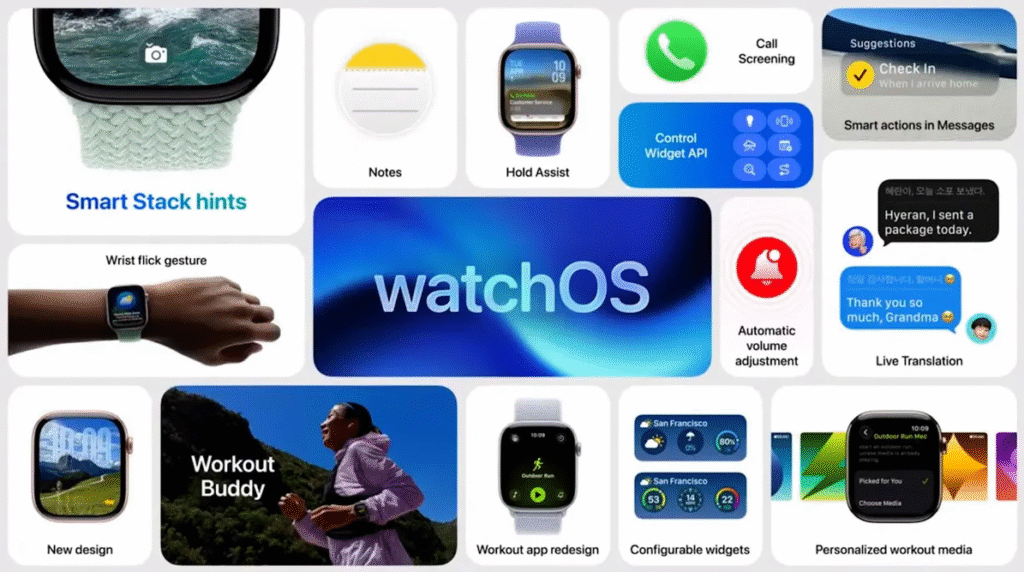
With watchOS 12, Apple continues to turn the Apple Watch into a powerful wellness companion and intelligent assistant. Here are the key updates:
- Vitals Dashboard: A brand-new feature that combines heart rate, respiratory rate, sleep stages, and now mood tracking into one cohesive overview. Users get proactive suggestions based on trends — like getting more hydration or sleep after a workout.
- AI-Powered Coaching: Using on-device machine learning, watchOS 12 provides dynamic workout recommendations, tailored to your fitness level and recent trends. It even adapts your routine if it notices stress or fatigue.
- Smart Stack 2.0: The new Smart Stack uses location and activity data to surface the right widgets at the right time — whether it’s your boarding pass at the airport or a meditation prompt during a stressful meeting.
- Enhanced Siri on Watch: With faster processing and voice models running on-device, Siri now responds 30% faster and can handle more complex requests, like sending messages, starting timers, and logging workouts without your phone nearby.
Apple Watch also gains new watch faces, additional keyboard support for select languages, and enhanced gesture control for accessibility.
📺 tvOS 18: Personalization Meets Home Automation

tvOS 18 brings subtle but powerful changes that make Apple TV an even stronger hub for both entertainment and smart home control:
- Adaptive Frame Mode: Automatically adjusts display settings based on content — movies get richer contrast while games prioritize smoother frame rates.
- Shared Profiles: Multiple users can now have their own content recommendations, resume points, and app preferences.
- HomeKit Scenes on TV: Apple TV now doubles as a full HomeKit dashboard. With the new Control Center overlay, users can control lights, cameras, and temperature right from their screen — perfect for home theaters and family setups.
- Fitness+ Upgrades: With improved Apple Watch integration, users get real-time feedback and adaptive workouts on-screen based on their vitals.
While tvOS updates often go under the radar, the combination of personalized content and smart home control makes Apple TV a more central part of the connected living room.
👨💻 New Developer Tools & APIs: Powering the Next Generation of Apps
WWDC has always been a developer-centric event at its core, and in 2025, Apple doubled down on giving developers more powerful, efficient, and intelligent tools to build apps across all platforms — from iOS and macOS to visionOS and beyond.
🧰 Xcode 17: Built for AI and Spatial Computing

Apple introduced Xcode 17, a major update that adds significant performance improvements and new capabilities tailored to the demands of next-gen app development. Highlights include:
- AI Code Assist: Apple’s answer to tools like GitHub Copilot. It helps auto-complete Swift code, generate boilerplate functions, and even suggest UI layouts based on design comments.
- Instant Previews: Improved SwiftUI canvas with real-time preview syncing across iPhone, iPad, Mac, and Vision Pro simulators.
- Parallel Build System 2.0: Speeds up compile times, especially for large projects using Swift Packages and modular architecture.
📦 New APIs and SDKs
Apple unveiled several new APIs that open up deeper system access, smarter integrations, and new app capabilities:
- IntelligenceKit: Enables developers to tap into on-device AI — including summarization, smart replies, and image generation — without sending data to the cloud.
- RealityKit 3: Enhances spatial rendering, object occlusion, and anchor stability for visionOS apps.
- WidgetKit 2: Brings support for interactive widgets across all platforms — including Apple Watch and Mac desktop.
- HealthKit+: Now includes emotional well-being metrics and more granular sleep data, enabling better wellness apps.
🛠️ Swift 6: Modernized and More Performant
Swift 6, introduced alongside Xcode 17, brings major improvements in performance, safety, and concurrency. It simplifies parallel task handling with new @actor and async let enhancements — making Swift apps faster and more battery-efficient.
🌍 Developer Ecosystem Growth
Apple emphasized its global commitment to developers:
- Developer Labs opened in more regions including India, Brazil, and Southeast Asia.
- App Store SDK Updates now allow for more flexible subscription models, in-app donations, and expanded TestFlight groups for faster iteration.
🧩 No New Hardware? What That Means for Apple’s Future
For the first time in years, Apple’s WWDC 2025 event came and went without a single hardware announcement. No new MacBooks, no iPads, no new Vision Pro — a decision that surprised many in the tech world. But was this a misstep, or a calculated move?
🧠 A Strategic Shift Toward Software and AI
Rather than distracting the audience with shiny new devices, Apple made a deliberate choice to put software front and center. From iOS 26’s AI features to visionOS 2’s immersive upgrades, Apple emphasized that the future is about intelligence, integration, and seamless experiences — not just hardware specs.
This reflects a broader industry shift, where:
- AI and spatial computing are the new battlegrounds
- Operating systems are becoming smarter, more adaptive, and more deeply personalized
- Hardware cycles are slowing, and Apple is preparing for longer product life spans
💡 Setting the Stage for the September Event
Don’t be fooled — hardware is still coming. WWDC 2025 is simply the prelude. Apple is clearly laying the foundation for:
- iPhone 17 with iOS 26 built-in AI
- Possibly Apple Vision “Lite” in 2026
- New M4-powered Macs launching later this year
By revealing the OS first, Apple is giving developers time to adapt and users time to build anticipation for the devices that will eventually run them.
🗣️ Mixed Community Reaction
- Some developers appreciated the focus on tools and AI frameworks.
- Others, especially consumers, were disappointed by the absence of a new MacBook Air or Vision Pro price drop.
- Tech analysts, however, viewed the move as Apple “resetting the narrative” — shifting the focus from hardware upgrades to software intelligence.
“Apple knows that AI is the next platform — and WWDC 2025 is their clearest statement yet that they’re building it into everything, not just adding it to new devices.”
— TechCrunch Analyst at WWDC Panel Recap
With no hardware to steal the spotlight, Apple has positioned itself as a software-first innovator, preparing the ecosystem for a smarter, AI-driven future.
📣 Audience Reactions & Industry Response: The Verdict on WWDC 2025
As the curtains closed on WWDC 2025, one thing became clear — this wasn’t your typical Apple event. It wasn’t just about upgrades; it was about redefining user experiences with AI and software intelligence. But how did the tech world and everyday users react?
🗨️ Developer Community: Mostly Positive, Cautiously Optimistic
Among developers, the reception was largely positive — especially toward Xcode 17, Apple Intelligence, and expanded visionOS support.
- Swift 6 and AI-powered Xcode suggestions were seen as time-savers
- Many welcomed on-device AI APIs that avoid privacy pitfalls
- Vision Pro devs praised RealityKit 3 for simplifying spatial interaction
“No new Mac? No problem. Xcode 17 and IntelligenceKit are game-changing. WWDC 2025 is a pivot, and Apple’s serious about dev-first innovation.”
— @LinaCodesSwift (iOS Developer)
💬 Public Sentiment: Mixed but Curious
Casual Apple fans had a more mixed reaction — particularly those expecting new hardware. However, Apple’s bold push into AI didn’t go unnoticed:
- iOS 26’s dynamic interface and AI replies received praise
- Some called visionOS 2 the most “sci-fi” moment of the event
- Others missed the thrill of a new iPhone or Mac reveal
“No gadgets? Weird. But ngl, iOS 26 looks kinda insane. Apple’s finally catching up with the AI wave.”
— User comment on YouTube livestream
“This is the most ‘software-focused’ Apple keynote I’ve seen. They’re laying a long game here.”
— Reddit user /r/Apple
📰 Media & Analyst Reactions: Respect for Apple’s Patience
Tech analysts appreciated Apple’s disciplined approach. Rather than racing to drop an AI chatbot or headline-grabbing device, Apple showcased a deeply integrated, system-level vision for the future.
- The Verge called the event “a restrained but mature AI debut”
- Bloomberg highlighted Apple’s focus on “privacy-conscious AI”
- MKBHD tweeted: “Not a flashy keynote, but definitely a foundational one.”
Even critics acknowledged that Apple’s AI rollout feels more polished and practical than many of its rivals.
Apple didn’t try to win the hype war at WWDC 2025 — it played the long game, betting on real, system-deep AI and seamless user experiences. And the world is watching closely.
🔮 Conclusion & What Comes Next: Apple’s Software-First Future
WWDC 2025 wasn’t flashy — it was foundational.
Apple’s choice to spotlight iOS 26, macOS 15, visionOS 2, and a sweeping AI overhaul reflects a deep pivot: away from just shiny hardware and toward a tightly integrated ecosystem where AI, privacy, and user context shape the experience.
🧠 Intelligence Is the New Interface
With “Apple Intelligence” woven into every OS, we’re entering a new era of interaction:
- Your device doesn’t just respond — it understands
- Software adapts to you, not the other way around
- Creativity, productivity, and communication are becoming faster, smoother, and more intuitive
This isn’t about competing with OpenAI or Google in raw AI horsepower. Apple is taking a quieter route — focused on on-device AI, seamless design, and privacy at the core.
📅 What’s Next?
Now that the software foundation is set, the next few months are likely to bring:
- iPhone 17 (Fall 2025) with iOS 26 pre-installed and Apple Intelligence fully integrated
- Possibly a new Vision headset (2026) built for wider audiences
- Expanded AI development kits and hardware-optimized chips to run these features more efficiently
🔊 AirPods Pro 3 Incoming?
While not officially announced, the iOS 26 developer beta includes hints at AirPods Pro 3, likely coming later this year. Rumored features include:
- Improved spatial audio with head-tracking AI
- Adaptive noise transparency
- Enhanced integration with Apple Intelligence
For developers and users alike, the next phase of Apple’s evolution has clearly begun — and it’s smarter, more integrated, and designed to adapt to you.
📝 Final Takeaway
Apple didn’t just announce new features at WWDC 2025. It revealed its next decade of thinking: devices that don’t just do what you ask, but anticipate what you need — all while respecting your privacy.
If you’re a developer, the time to explore Apple Intelligence and visionOS development is now.
If you’re a user, get ready — your iPhone, iPad, and Mac are about to feel more personal than ever.
🙋♂️ Frequently Asked Questions (FAQ)
📅 When did Apple host WWDC 2025?
Apple hosted WWDC 2025 from June 9 to June 13, 2025, with the keynote event kicking off on June 9th. The conference was a hybrid of in-person sessions and online streams available to global developers.
📲 What are the top features of iOS 26 announced at WWDC 2025?
iOS 26 brings a host of AI-driven features, including:
- Apple Intelligence for on-device smart suggestions
- A redesigned Control Center 2.0
- New AI-powered Messages and Mail suggestions
- Custom emoji generation
- Lock screen widgets and dynamic home screens
🧠 What is “Apple Intelligence”?
Apple Intelligence is Apple’s system-wide AI integration launching with iOS 26, macOS 15, and more. It includes:
- On-device AI processing for privacy
- Smart summarization, email replies, and task handling
- Generative features like custom emojis and AI writing tools
👓 What’s new in visionOS 2 and Apple Vision Pro?
visionOS 2 enhances spatial computing with:
- Live Mac display integration
- Improved hand and eye tracking
- Personalized avatars for FaceTime
- New developer tools like RealityKit 3 and SpatialKit
💻 Was any new hardware announced at WWDC 2025?
No new hardware was introduced at WWDC 2025. Apple focused solely on software updates and AI advancements, possibly reserving hardware reveals for the Fall 2025 iPhone event.
⌚ What are the major updates in watchOS 12?
watchOS 12 introduced:
- Vitals Dashboard combining wellness data
- AI-powered fitness coaching
- Smarter widget stacks
- Faster on-device Siri and gesture-based controls
🛠️ What’s new for developers?
WWDC 2025 launched:
- Xcode 17 with AI coding suggestions
- Swift 6 with better concurrency
- New APIs like IntelligenceKit and WidgetKit 2
- Expanded support for spatial apps and mixed reality experiences
🔐 Is Apple’s AI safe and private?
Yes. Apple emphasized that most AI features are processed on-device, with no cloud syncing unless explicitly permitted. Apple’s approach prioritizes privacy-first machine learning.
